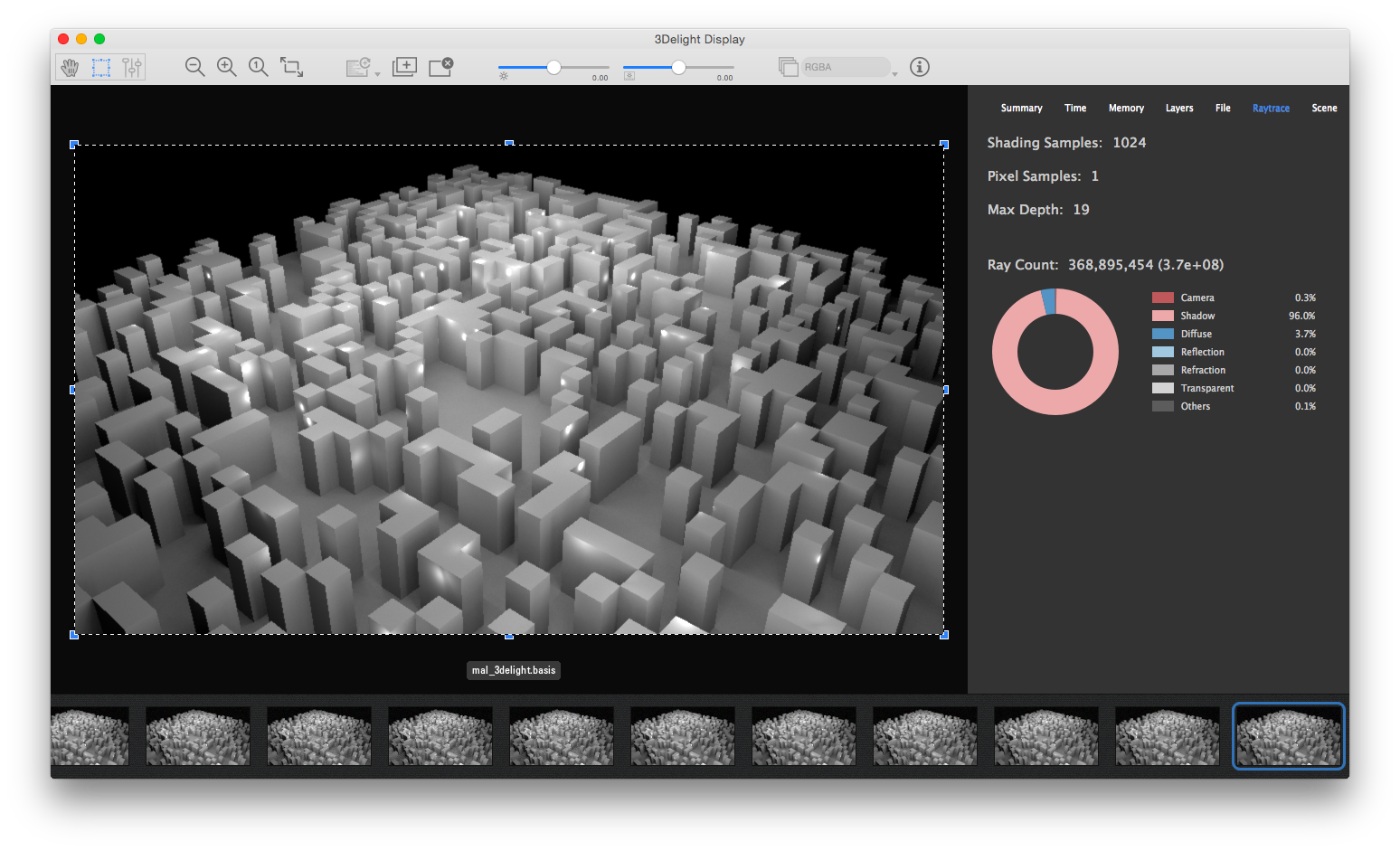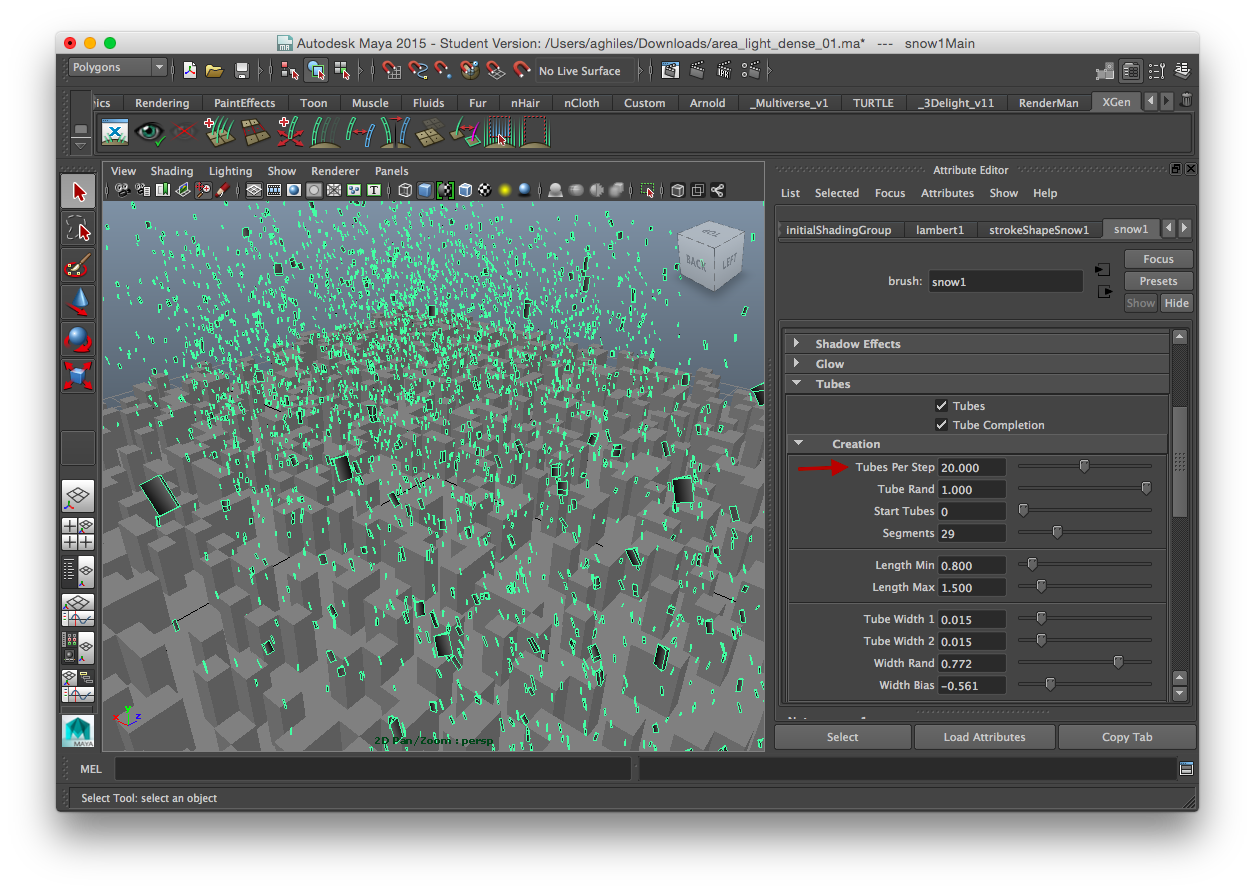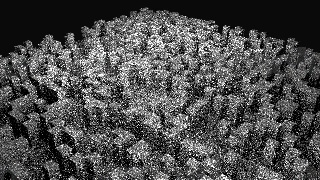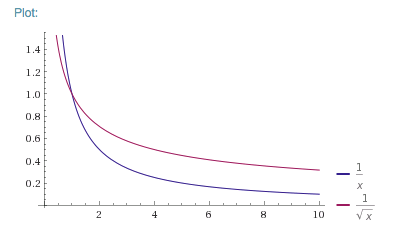

It is not uncommon for production scenes to rely heavily on geo area lights. In this test we will compare geo light sampling technology in 3Delight OSL, Arnold and RenderMan/RIS. We will use a test with a geometric area light that is composed of a relatively large number of faces. The test, although limited, should allow us to find the convergence rate of each algorithm as well as general performance.
 The test scene allows for procedural generation of floating area lights using the "Tubes Per Step" PaintEffects attribute.
The test scene allows for procedural generation of floating area lights using the "Tubes Per Step" PaintEffects attribute.
The scene is designed to procedurally generate a number of area lights floating on top of a "city".
RenderMan/RIS 21 is about to be released with new sampling technology. We will complete the test as soon as the renderer is available. |
| Arnold | RenderMan/RIS | 3Delight OSL | |
|---|---|---|---|
| Version |
|
|
|
| Technology | Unidirectional path tracer. | Using unidirectional path tracer. Other options are available but not useful for this test. | Unidirectional path tracer. |
| Shaders | C++ | C++ | OSL |
We are interested to find out about:
We will start by creating a "ground truth" image for each renderer; an image generated by using a very large amount of samples so there is no more apparent noise. Although it is normal for images generated by each renderer to vary slightly, encouragingly, images produced by both 3Delight and Arnold are almost exactly the same. We will then render several images with varying amount of samples and measure the RMSE between these images and the ground truth for each renderer. Timings and statistics will be collected at each render. Having this data will allow us to draw a conclusion about the convergence rate and general performance.
We use a 1x1 pixel sample in all renderers. Adaptivity is disabled as well as all additional bounces. In Arnold, the light samples are attributes of the geometry. In RenderMan/RIS the light samples are attributes of a custom shape. In 3Delight, the light attributes are on Maya's area light.
Admittedly, those are not standard settings for any useful render. The goal here is to isolate one algorithm in order to understand its behaviour. Understanding an algorithm can shed light on its strengths and weaknesses and allows us to draw interesting conclusions for the more general case. |
| Arnold | RenderMan/RIS | 3Delight OSL | |
|---|---|---|---|
| General Parameters |
|
|
|
| Geo Light Parameters |
|
|
|
Arnold — For light samples, Arnold uses effective sample counts that are proportional – within a constant – to the square of the user specified value. As we will see, this makes sense from a UI standpoint since the variance follows the inverse of the same rule in the case of Arnold. This makes the light samples slider linear in term of perceived noise. In the Arnold tables below, we will specify the effective samples per pixel along with the user samples. Those effective samples are gathered from Arnold's diagnostics files.
RenderMan/RIS – While in Arnold the light samples effectively control image quality when only direct lighting is needed, in RenderMan/RIS, we had to match light samples count with BxDF samples count to achieve acceptable quality and satisfactory convergence rates. Using light samples only, or BxDF samples only, produced noisy renders. In the RenderMan/RIS results below, "N samples" means N samples for both light and BxDF. We did all the tests with the "advanced (mode 4)" light sampler since it produced the best results. The samples used by the renderer are the ones entered in the UI and are not squared as in Arnold. Note that we used the path tracer with one bounce instead of the "direct lighting" algorithm for one of the images because of a crash (quality and speed did not seem to suffer although there were some minor differences in the render).
3Delight – We have only one control for the general quality of the render. In the case of direct lighting, 3Delight "understands" that samples are best used for light sampling and that's what it does. As the tests will show, those samples have a linear impact on perceived noise levels.
| The following graph gives a good idea on the convergence rate of the different light samplers. |
| |||||||||||||||||||||||||||||||||||||||||||||||||||||||
| The following graph shows the time required to achieve a certain quality. From user's perspective, this is an important quantity. |
| |||||||||||||||||||||||||||||||||||||||||||||||||||||||
| The following graph shows how much time it takes to build the acceleration data structure depending on sample/ray count. |
|
*TTFP = Time to first pixel.
| Samples (effective) | 2 (1.23) | 4 (4.91) | 8 (19.64) | 10 (30) | 16 (78.56) | 32 (314.29) | 64 (1257.18) |
|---|---|---|---|---|---|---|---|
| Image |  |
|
|
|
|
|
|
| Time | 1 sec. | 2 sec. | 6 sec. | 9 sec. | 21 sec. | 81 sec. | 492 sec. |
| TTFP* | 0 sec. | 0.35 sec. | 1.2 sec. | 2.0 sec. | 3.2 sec. | 11 sec. | 41 sec. |
| Shadow Rays | 0.678 M | 3.26 M | 10.8 M | 16.94 M | 43.4 M | 173.6 M | 694.5 M |
| RMSE | 0.15699 | 0.100115 | 0.0501787 | 0.0396399 | 0.0242515 | 0.0117413 | 0.00693426 |
| Samples | 2 | 4 | 8 | 16 | 32 | 64 | 128 | 256 |
|---|---|---|---|---|---|---|---|---|
| Image |
|
|
|
|
|
|
|
|
| Time | 5.24 sec. | 7.18 sec. | 11.21 sec. | 20.68 sec. | 35.86 sec. | 69.48 sec. | 134.18 sec. | 265.05 sec. |
| TTFP | 2 sec. | 2 sec. | 2 sec. | 2 sec. | 2 sec. | 2 sec. | 2 sec. | 2 sec. |
| Shadow Rays | 2.45 M | 3.13 M | 4.51 M | 7.27 M | 12.78 M | 23.8 M | 45.88 M | 90.1 M |
| RMSE | 0.0933142 | 0.0658266 | 0.0441248 | 0.0290439 | 0.0185575 | 0.0117566 | 0.00752546 | 0.00449892 |
| Samples | 1 | 2 | 4 | 8 | 16 | 32 | 64 | 256 | 512 | 1024 |
|---|---|---|---|---|---|---|---|---|---|---|
| Image |
|
|
|
|
|
|
|
|
|
|
| Time | 6.74 sec. | 7.23 sec. | 7.99 sec. | 9.42 sec. | 12.12 sec. | 18.51 sec. | 29.40 sec. | 98.08 sec. | 195.77 sec. | 6:23.39 min:sec. |
| TTFP | 3.1 sec. | 3.2 sec. | 4 sec. | 4.7 sec. | 6.7 sec. | 9 sec. | 15.5 sec. | 51.2 sec. | 97 sec. | |
| Rays | 1.47 M | 2.94 M | 5.88 M | 11.7 M | 21.1M | 47.02 M | 94.14 M | 376.3 M | 751.3 M | 1499 M |
| RMSE | 0.151125 | 0.121487 | 0.0953649 | 0.0728148 | 0.0520606 | 0.0373876 | 0.0265388 | 0.0138148 | 0.00854045 | 0.00396 |

| RenderMan/RIS | Arnold | 3Delight | |
|---|---|---|---|
| Images and Stats | arnold.tar.gz | 3delight.tar.gz | |
| Maya Scene | mal_prman.ma | mal_3delight.ma | |
| Remarks | The same scene works with both 3Delight and Arnold | ||